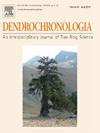Local timber dominated pre-industrial construction: Insights from archival and dendrochronological data
IF 2.7
3区 农林科学
Q1 FORESTRY
引用次数: 0
Abstract
In pre-modern Europe, timber was notoriously difficult and costly to transport on land, therefore it is usually assumed that ordinary buildings – except for those close to navigable watercourses – were constructed using timber from local sources. We hypothesized that species of timber used in constructions prior to the late 19th century were commonly available in forests within a short distance from the location of the constructions. To test this hypothesis, we compared high-resolution archival information on the tree species composition of forests in Moravia (eastern Czech Republic, ca. 27,000 km2) in the 18th and 19th centuries to a database of 1231 dated timber constructions in the same region and period. Our analysis was based on the mutual distances between the locations of timber constructions and the occurrences of forests with the given tree species. We compared real distances with distances obtained through random simulations. Results showed that in more than half of the cases, the tree species from constructions occurred in the forests of the same township. In the rest of the cases, the modal distance values to the centroid of the nearest township where the same species was present in the forests were usually less than two kilometres and distances larger than five kilometres were generally rare. While our results testify to the availability of timber rather than to the direct source of particular pieces of timber, they strongly suggest that timber was usually sourced locally. We believe our interdisciplinary study demonstrated the usefulness of archival data in the research of timber sourcing. For future studies, we see the combination of our approach with dendroprovenancing and other natural scientific methods as the most promising way to gain deeper knowledge on the sourcing of timber.
当地木材主导前工业建筑:来自档案和树木年代学数据的见解
在前现代欧洲,木材在陆地上运输是出了名的困难和昂贵,因此通常认为普通建筑物-除了靠近通航水道的建筑物-都是用当地的木材建造的。我们假设,在19世纪末之前,建筑中使用的木材种类通常可以在离建筑位置很近的森林中找到。为了验证这一假设,我们将18世纪和19世纪摩拉维亚(捷克共和国东部,约27,000 km2)森林树种组成的高分辨率档案信息与同一地区和同一时期的1231个木结构建筑的数据库进行了比较。我们的分析是基于木结构建筑的位置和给定树种的森林发生之间的相互距离。我们将实际距离与随机模拟得到的距离进行了比较。结果表明,半数以上的工程树种发生在同一乡镇的森林中。在其他情况下,与森林中存在相同物种的最近乡镇的质心的模态距离值通常小于2公里,大于5公里的距离通常很少。虽然我们的研究结果证明了木材的可用性,而不是特定木材的直接来源,但它们强烈表明木材通常是在当地采购的。我们相信我们的跨学科研究证明了档案数据在木材采购研究中的有用性。对于未来的研究,我们认为将我们的方法与树木改良和其他自然科学方法相结合是最有希望获得更深入的木材来源知识的方法。
本文章由计算机程序翻译,如有差异,请以英文原文为准。
求助全文
约1分钟内获得全文
求助全文
来源期刊

Dendrochronologia
FORESTRY-GEOGRAPHY, PHYSICAL
CiteScore
5.50
自引率
13.30%
发文量
82
审稿时长
22.8 weeks
期刊介绍:
Dendrochronologia is a peer-reviewed international scholarly journal that presents high-quality research related to growth rings of woody plants, i.e., trees and shrubs, and the application of tree-ring studies.
The areas covered by the journal include, but are not limited to:
Archaeology
Botany
Climatology
Ecology
Forestry
Geology
Hydrology
Original research articles, reviews, communications, technical notes and personal notes are considered for publication.
 求助内容:
求助内容: 应助结果提醒方式:
应助结果提醒方式:


